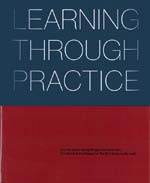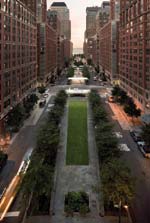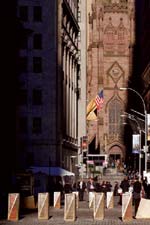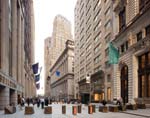
|

|
|
Home Site Search Contact Us Subscribe
|
|
Delicately Rearranging Intangibles in Public Space: The Art of Rogers Partners Architects+Urban Designers in "Learning Through Practice" A new monograph highlights transformative designs by a firm strikingly dedicated to re-enchanting public space. By Norman Weinstein February 12, 2015 Please join me for an imaginative reformulation of architectural history for the sake of discovering new pleasures, architecturally, in public space. Move over, Vitruvius. Make way for Lao Tzu, your Asian forerunner who wrote in his Tao Te Ching, a 6th-century, BC, spiritual, as well as practical guide for living lightly:
We make doors and windows for a room. But it is these empty spaces that make the room livable. Thus, while the tangible has advantages, It is the intangible that makes it work. (John C.H. Wu translation)
Juxtapose that 6th-century, BC, utterance with the following statement by architect and urban designer Robert M. Rogers, the founding principal of New York City-based Rogers Partners Architects+Urban Designers, found in Learning Through Practice (ORO Editions, 2015):
We delight in the impact of small things, understanding that authenticity involves much you can’t or don’t see, that what we open is as critical as what we enclose, and that our overall impact on culture matters.
Whether or not Rob Rogers and the extravagantly talented team at Rogers Partners have ever studied Lao Tzu or other Asian metaphysicians isn’t relevant. More than any other architectural firm of my acquaintance, their practice has exemplified a talent for arranging often invisible intangibles into captivating public spaces with a sensibility Lao Tzu would appreciate. This no-nonsense monograph, filled with concisely insightful commentary and apt graphics, describes 13 projects that make tangible that rare achievement.
Maintaining site security without compromising enlivening and esthetically gratifying public access is a major theme linking several projects. This was stunningly realized in the plan for President’s Park South, an ever-popular gathering place that must be a favorite backdrop for nightmares experienced by the Secret Service, given its close proximity to the White House. Rogers Partners found an uncanny approach to forging a balance honoring satisfying public needs with intense security requirements. “It is hard to believe that two one-hundredths of an inch can be important on an urban scale,” notes Rogers. But that barely detectable difference made all the difference in the world as the design team realized that tilting the familiar ellipse ever so slightly opened up an unexpected sightline from the park to White House, while also making possible the insertion of a low, earth-backed wall for security that seconds as a bench. Talk about “value added”! Or, as Rogers notes with an understatement that would have pleased Lao Tzu: “Every design move has to be small, light, delicate – almost inconsequential ... Little things add up to a lot.”
What this firm has done in response to ever-demanding security requirements is counterintuitive. Think of rigorous security constraints on an urban scale and painfully ugly barriers float into mind. But Rogers Partners assumes that security measures should contribute to the quality of urban life, a seemingly quixotic quest when one recalls the grotesque proliferation of Jersey barriers and outsized stone blocks and planters that sprouted in New York City’s Financial District after 9/11. Rogers Partners designed a bikeway and walkway, as well as a landscaped apron, circling each of the World Financial Center buildings. These interventions wrapped security needs into a large, constructed fabric catalyzing lively urban life.
But there is more to this firm’s creativity than ingenuous security solutions for complex public spaces. A key lesson learned repeatedly from the firm’s high-profile, security-driven projects is how small, barely perceptible and intangible factors can make a huge difference in re-defining, even re-enchanting public space as artistic passages. Rogers Partners achieved a sense of magical lightness in designing the West Kowloon Arts Pavilion in Hong Kong through an imaginative use of reflective glass surfaces that dissolve the pavilion’s mass into sky and water. The pavilion creates the illusion of being there and not-there simultaneously for art lovers, a not-distant cousin to “The Blur Building” by Diller Scofidio + Renfro, and SANAA’s Glass Pavilion at the Toledo Museum of Art. This is an architecture of bracing transparency that has more to do the spiritual typography of Lao Tzu’s Taoism and Zen Buddhism than with the dandyish exhibitionism of Philip Johnson’s Glass House. Impressive public spaces invite the peacock-proud exhibitionist in us to strut our stuff – but artfully fashioned public spaces also invite deep contemplative thinking, individually and collectively.
This book offers a distillation of how designing great public spaces is as delicate an art as arranging a Japanese rock garden – and as robust an enterprise as protecting, gracefully, New York’s Financial District. Few architectural firms are as attentive to economy of means – in every sense – in order to form public spaces fulfilling our humanity at its best.
Editor’s note: Teams from Rogers Partners Architects+Urban Designers, or the predecessor firm, Rogers Marvel Architects, have contributed to the work presented in the book.
Norman Weinstein writes about architecture and design for Architectural Record, and is the author of “Words That Build” – an exclusive 21-part series published by ArchNewsNow.com – that focuses on the overlooked foundations of architecture: oral and written communication. He consults with architects and engineers interested in communicating more profitably; his webinars are available from ExecSense. He can be reached at nweinstein@q.com.
More by Weinstein:
An exclusive 21-part series that focuses on the overlooked foundations of architecture: oral and written communication.
Weinstein: From Ada to Zaha and Everything In Between Op-eds, book reviews, musings, and debate. |
(click on pictures to enlarge) 
 Rendering courtesy Rogers Partners Architects+Urban Designers President’s Park South with view of the White House.  Rendering courtesy Rogers Partners Architects+Urban Designers President’s Park site, aerial view.  Photo courtesy Paul Warhol Battery Park City North End Boulevard, aerial view.  Photo courtesy Paul Warhol New York Stock Exchange chiaroscuro.  Photo courtesy Paul Warhol Turntable at Wall Street.  Rendering courtesy Rogers Partners Architects+Urban Designers West Kowloon Arts Pavilion entrance view.  Rendering courtesy Rogers Partners Architects+Urban Designers West Kowloon Arts Pavilion harbor at night. |
© 2015 ArchNewsNow.com